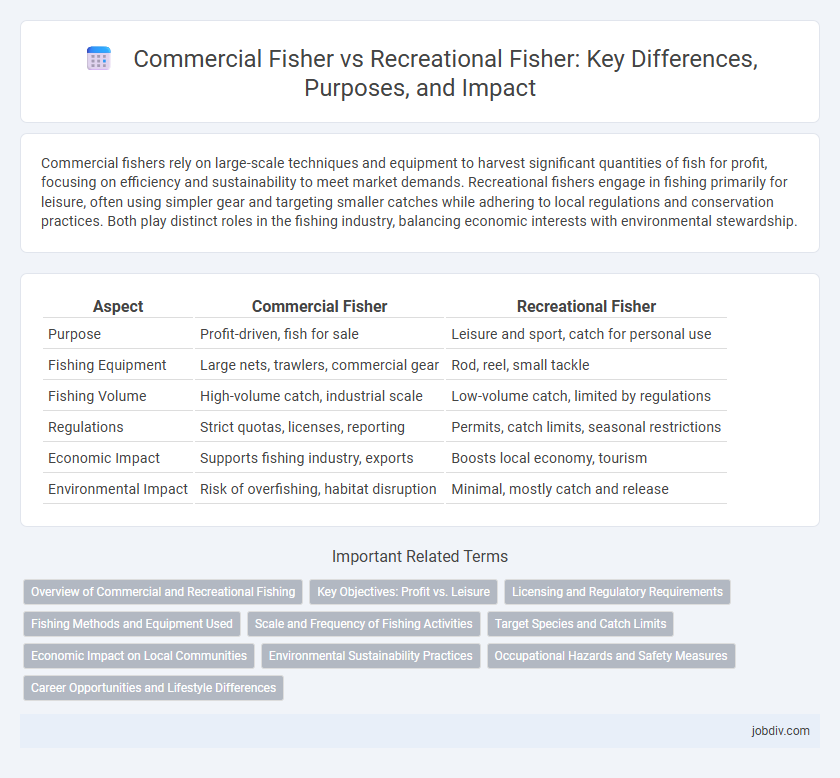Commercial fishers rely on large-scale techniques and equipment to harvest significant quantities of fish for profit, focusing on efficiency and sustainability to meet market demands. Recreational fishers engage in fishing primarily for leisure, often using simpler gear and targeting smaller catches while adhering to local regulations and conservation practices. Both play distinct roles in the fishing industry, balancing economic interests with environmental stewardship.
Table of Comparison
| Aspect | Commercial Fisher | Recreational Fisher |
|---|---|---|
| Purpose | Profit-driven, fish for sale | Leisure and sport, catch for personal use |
| Fishing Equipment | Large nets, trawlers, commercial gear | Rod, reel, small tackle |
| Fishing Volume | High-volume catch, industrial scale | Low-volume catch, limited by regulations |
| Regulations | Strict quotas, licenses, reporting | Permits, catch limits, seasonal restrictions |
| Economic Impact | Supports fishing industry, exports | Boosts local economy, tourism |
| Environmental Impact | Risk of overfishing, habitat disruption | Minimal, mostly catch and release |
Overview of Commercial and Recreational Fishing
Commercial fishing involves large-scale operations that harvest seafood for sale, using advanced equipment and vessels to capture vast quantities of fish and shellfish, significantly impacting global seafood supply chains. Recreational fishing, practiced primarily for leisure or sport, employs smaller gear and targets specific species, contributing to local economies through tourism and equipment sales. Both sectors influence fish populations and aquatic ecosystems, necessitating management policies to balance economic benefits with environmental sustainability.
Key Objectives: Profit vs. Leisure
Commercial fishers prioritize maximizing catch volume and profitability by targeting high-demand species using efficient, large-scale equipment and methods, ensuring sustained business operations. Recreational fishers engage in fishing primarily for leisure, valuing enjoyment, relaxation, and personal satisfaction over catch quantity or commercial gain. The distinction between profit-driven commercial fishing and experience-driven recreational fishing significantly impacts fishing regulations, resource management, and conservation strategies.
Licensing and Regulatory Requirements
Commercial fishers are subject to stringent licensing and regulatory requirements, including quotas, gear restrictions, and seasonal closures, to ensure sustainable fishery management and ecosystem protection. Recreational fishers typically need simpler licenses with fewer regulations, often focused on bag limits and specific fishing seasons to minimize ecological impact. These differentiated frameworks reflect the varying scales of impact and economic importance associated with commercial versus recreational fishing activities.
Fishing Methods and Equipment Used
Commercial fishers utilize advanced gear such as trawlers, longlines, and gillnets to harvest large quantities of fish efficiently, often targeting specific species. Recreational fishers employ lighter equipment like rods, reels, and baitcasting gear designed for sport and personal use, emphasizing catch-and-release or limited harvest practices. The commercial approach prioritizes volume and sustained yield, while recreational fishing focuses on technique, experience, and minimal environmental impact.
Scale and Frequency of Fishing Activities
Commercial fishers operate on a larger scale, deploying extensive fleets and fishing equipment targeting high-volume harvests to supply markets consistently. Recreational fishers engage in fishing occasionally, often for personal leisure or sport, using smaller gear and capturing limited quantities. The frequency of commercial fishing is daily or weekly, while recreational fishing occurs sporadically, influenced by seasons and personal availability.
Target Species and Catch Limits
Commercial fishers primarily target high-value species such as tuna, salmon, and shrimp, often operating under strict catch quotas set by regulatory agencies to prevent overfishing and ensure sustainable stock levels. Recreational fishers typically aim for a diverse range of species including bass, trout, and walleye, with catch limits designed to promote conservation and maintain sport fishing opportunities. Catch limits for commercial fishing are usually higher but rigorously monitored, whereas recreational limits are lower and frequently enforced through permit and reporting requirements.
Economic Impact on Local Communities
Commercial fishers generate significant economic value for local communities through large-scale catch volumes, job creation, and export revenues, fueling regional economies and supporting associated industries such as processing and equipment supply. Recreational fishers contribute to the local economy by driving tourism, increasing demand for hospitality services, and supporting small businesses like bait shops and charter operators, creating diverse income streams. Both sectors play vital roles in sustaining economic stability, but commercial fishing typically provides higher direct fiscal input, while recreational fishing enhances broader community engagement and tourism-related growth.
Environmental Sustainability Practices
Commercial fishers implement advanced sustainable practices such as quota systems, selective gear technology, and bycatch reduction devices to minimize ecosystem disruption and support fish population recovery. Recreational fishers often promote catch-and-release techniques and seasonal fishing restrictions, contributing to habitat preservation and species conservation. Collaboration between commercial and recreational sectors enhances marine biodiversity and promotes long-term environmental sustainability in global fisheries.
Occupational Hazards and Safety Measures
Commercial fishers face significant occupational hazards including adverse weather, heavy machinery accidents, and long working hours that increase fatigue and risk of injury. Recreational fishers encounter less severe but still notable dangers such as drowning, watercraft accidents, and exposure to sun and cold. Safety measures for commercial fishers emphasize mandatory use of personal protective equipment (PPE), vessel safety regulations, and emergency preparedness training, while recreational fishers benefit from life jacket use, adherence to local fishing regulations, and weather condition awareness.
Career Opportunities and Lifestyle Differences
Commercial fishers often pursue steady employment with higher income potential, working long hours in demanding conditions to supply seafood markets globally. Recreational fishers typically engage in fishing as a leisure activity, balancing it with other careers, and enjoy flexible schedules and a lifestyle centered on relaxation and outdoor enjoyment. Career opportunities in commercial fishing include vessel operation, processing, and management, while recreational fishing offers pathways in guiding, tourism, and conservation education.
Commercial Fisher vs Recreational Fisher Infographic

 jobdiv.com
jobdiv.com